tire type SATURN ASTRA 2009 Owners Manual
[x] Cancel search | Manufacturer: SATURN, Model Year: 2009, Model line: ASTRA, Model: SATURN ASTRA 2009Pages: 314, PDF Size: 1.94 MB
Page 168 of 314
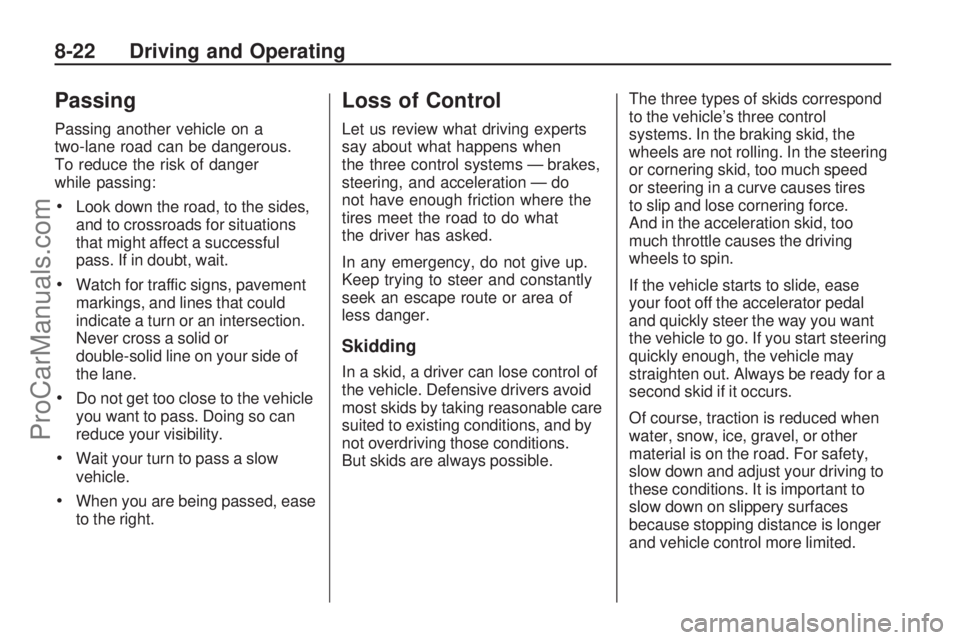
Passing
Passing another vehicle on a
two-lane road can be dangerous.
To reduce the risk of danger
while passing:
Look down the road, to the sides,
and to crossroads for situations
that might affect a successful
pass. If in doubt, wait.
Watch for traffic signs, pavement
markings, and lines that could
indicate a turn or an intersection.
Never cross a solid or
double-solid line on your side of
the lane.
Do not get too close to the vehicle
you want to pass. Doing so can
reduce your visibility.
Wait your turn to pass a slow
vehicle.
When you are being passed, ease
to the right.
Loss of Control
Let us review what driving experts
say about what happens when
the three control systems — brakes,
steering, and acceleration — do
not have enough friction where the
tires meet the road to do what
the driver has asked.
In any emergency, do not give up.
Keep trying to steer and constantly
seek an escape route or area of
less danger.
Skidding
In a skid, a driver can lose control of
the vehicle. Defensive drivers avoid
most skids by taking reasonable care
suited to existing conditions, and by
not overdriving those conditions.
But skids are always possible.The three types of skids correspond
to the vehicle’s three control
systems. In the braking skid, the
wheels are not rolling. In the steering
or cornering skid, too much speed
or steering in a curve causes tires
to slip and lose cornering force.
And in the acceleration skid, too
much throttle causes the driving
wheels to spin.
If the vehicle starts to slide, ease
your foot off the accelerator pedal
and quickly steer the way you want
the vehicle to go. If you start steering
quickly enough, the vehicle may
straighten out. Always be ready for a
second skid if it occurs.
Of course, traction is reduced when
water, snow, ice, gravel, or other
material is on the road. For safety,
slow down and adjust your driving to
these conditions. It is important to
slow down on slippery surfaces
because stopping distance is longer
and vehicle control more limited.
8-22 Driving and Operating
ProCarManuals.com
Page 170 of 314
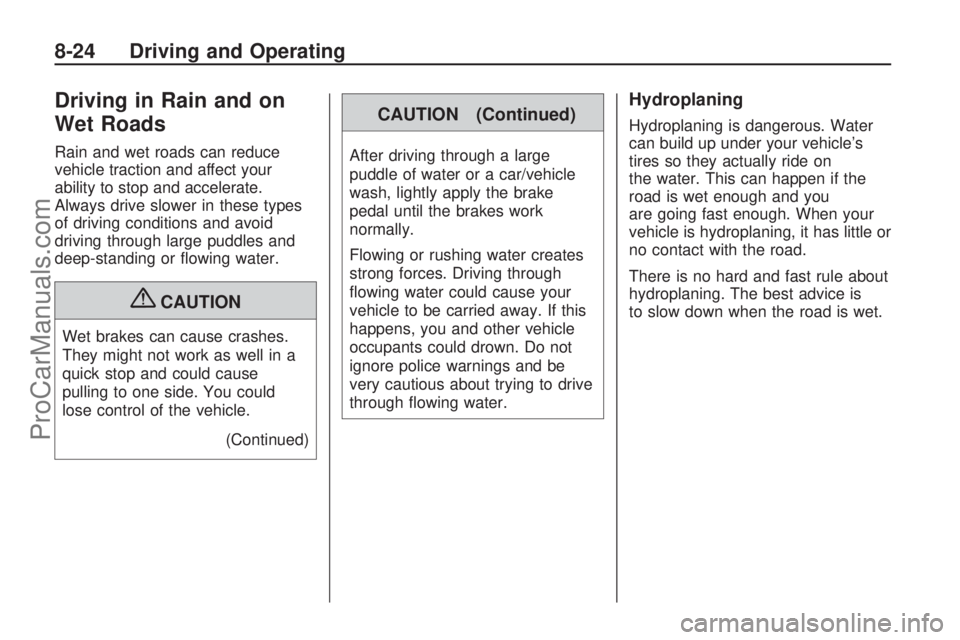
Driving in Rain and on
Wet Roads
Rain and wet roads can reduce
vehicle traction and affect your
ability to stop and accelerate.
Always drive slower in these types
of driving conditions and avoid
driving through large puddles and
deep-standing or �owing water.
{CAUTION
Wet brakes can cause crashes.
They might not work as well in a
quick stop and could cause
pulling to one side. You could
lose control of the vehicle.
(Continued)
CAUTION (Continued)
After driving through a large
puddle of water or a car/vehicle
wash, lightly apply the brake
pedal until the brakes work
normally.
Flowing or rushing water creates
strong forces. Driving through
�owing water could cause your
vehicle to be carried away. If this
happens, you and other vehicle
occupants could drown. Do not
ignore police warnings and be
very cautious about trying to drive
through �owing water.
Hydroplaning
Hydroplaning is dangerous. Water
can build up under your vehicle’s
tires so they actually ride on
the water. This can happen if the
road is wet enough and you
are going fast enough. When your
vehicle is hydroplaning, it has little or
no contact with the road.
There is no hard and fast rule about
hydroplaning. The best advice is
to slow down when the road is wet.
8-24 Driving and Operating
ProCarManuals.com
Page 225 of 314

Low-Pro�le Tires
If the vehicle has 225/40ZR18 or
215/45R18 size tires, they
are classi�ed as low-pro�le
performance tires. These tires
are designed for very responsive
driving on wet or dry pavement.
You may also notice more
road noise with low-pro�le
performance tires and that they
tend to wear faster.
Notice:If the vehicle has
low-pro�le tires, they are more
susceptible to damage from
road hazards or curb impact
than standard pro�le tires.
Tire and/or wheel assembly
damage can occur when
coming into contact with road
hazards like, potholes, or
sharp edged objects, or when
sliding into a curb. The vehicle
warranty does not cover this
type of damage. Keep tires
set to the correct in�ationpressure and, when possible
avoid contact with curbs,
potholes, and other road
hazards.
Winter Tires
If the vehicle has 225/40ZR18 or
215/45R18 size tires, they are
classi�ed as low-pro�le performance
tires. These tires are designed for
very responsive driving on wet or dry
pavement. If you expect to drive
on snow or ice covered roads often,
you may want to get winter tires
for your vehicle. All season tires
provide good overall performance on
most surfaces but they may not
offer the traction you would like or
the same level of performance
as winter tires on snow or ice
covered roads.
Winter tires, in general, are
designed for increased traction
on snow and ice covered roads.With winter tires, there may be
decreased dry road traction,
increased road noise, and shorter
tire tread life. After switching to
winter tires, be alert for changes in
vehicle handling and braking.
See your dealer/retailer for details
regarding winter tire availability
and proper tire selection. Also, see
Buying New Tires on page 9-54.
If you choose to use winter tires:
Use tires of the same brand and
tread type on all four wheel
positions.
Use only radial ply tires of the
same size, load range, and
speed rating as your original
equipment tires.
Winter tires with the same speed
rating as the original equipment tires
may not be available for H, V, W,
Y and ZR speed rated tires.
If you choose winter tires with a
lower speed rating, never exceed
the tire’s maximum speed capability.
Vehicle Service and Care 9-41
ProCarManuals.com
Page 226 of 314

Tire Sidewall Labeling
Useful information about a tire
is molded into its sidewall.
The examples below show a
typical passenger vehicle tire and
a compact spare tire sidewall.
(A) Tire Size
:The tire size is
a combination of letters and
numbers used to de�ne a
particular tire’s width, height,
aspect ratio, construction type,
and service description.See the “Tire Size” illustration
later in this section for more
detail.
(B) TPC Spec (Tire
Performance Criteria
Speci�cation)
:Original
equipment tires designed to
GM’s speci�c tire performance
criteria have a TPC speci�cation
code molded onto the sidewall.
GM’s TPC speci�cations meet
or exceed all federal safety
guidelines.
(C) DOT (Department of
Transportation)
:The
Department of Transportation
(DOT) code indicates that
the tire is in compliance with
the U.S. Department of
Transportation Motor Vehicle
Safety Standards.
(D) Tire Identi�cation Number
(TIN)
:The letters and numbers
following DOT (Department
of Transportation) code is the
Tire Identi�cation Number (TIN).The TIN shows the manufacturer
and plant code, tire size, and
date the tire was manufactured.
The TIN is molded onto both
sides of the tire, although only
one side may have the date
of manufacture.
(E) Tire Ply Material
:The type
of cord and number of plies in the
sidewall and under the tread.
(F) Uniform Tire Quality
Grading (UTQG)
:Tire
manufacturers are required to
grade tires based on three
performance factors: treadwear,
traction, and temperature
resistance. For more information
seeUniform Tire Quality
Grading on page 9-57.
(G) Maximum Cold In�ation
Load Limit
:Maximum load
that can be carried and
the maximum pressure needed
to support that load.
Passenger (P-Metric) Tire
Example
9-42 Vehicle Service and Care
ProCarManuals.com
Page 227 of 314
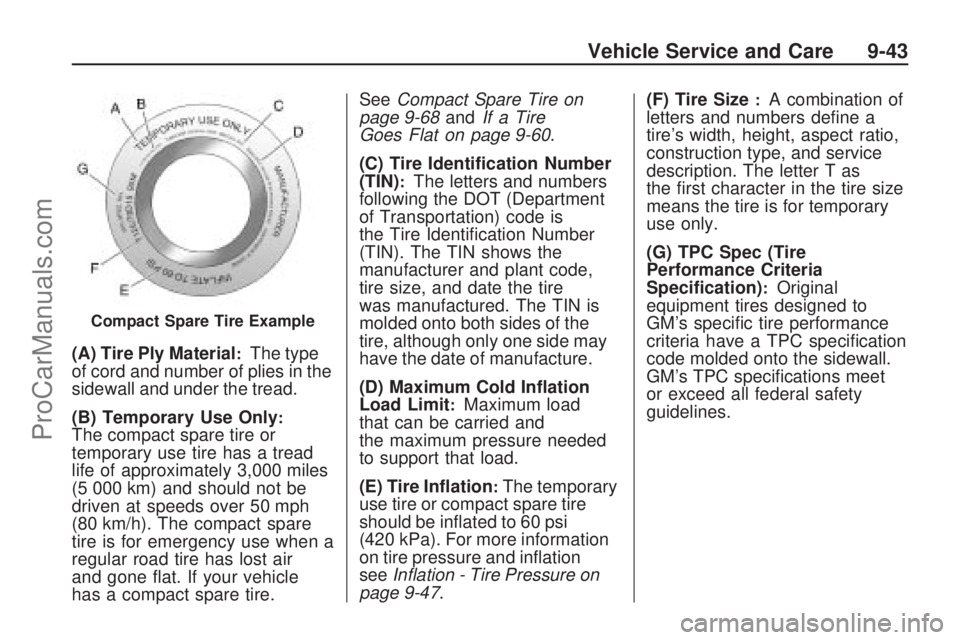
(A) Tire Ply Material:The type
of cord and number of plies in the
sidewall and under the tread.
(B) Temporary Use Only
:The compact spare tire or
temporary use tire has a tread
life of approximately 3,000 miles
(5 000 km) and should not be
driven at speeds over 50 mph
(80 km/h). The compact spare
tire is for emergency use when a
regular road tire has lost air
and gone �at. If your vehicle
has a compact spare tire.SeeCompact Spare Tire on
page 9-68andIf a Tire
Goes Flat on page 9-60.
(C) Tire Identi�cation Number
(TIN)
:The letters and numbers
following the DOT (Department
of Transportation) code is
the Tire Identi�cation Number
(TIN). The TIN shows the
manufacturer and plant code,
tire size, and date the tire
was manufactured. The TIN is
molded onto both sides of the
tire, although only one side may
have the date of manufacture.
(D) Maximum Cold In�ation
Load Limit
:Maximum load
that can be carried and
the maximum pressure needed
to support that load.
(E) Tire In�ation
:The temporary
use tire or compact spare tire
should be in�ated to 60 psi
(420 kPa). For more information
on tire pressure and in�ation
seeInflation - Tire Pressure on
page 9-47.(F) Tire Size
:A combination of
letters and numbers de�ne a
tire’s width, height, aspect ratio,
construction type, and service
description. The letter T as
the �rst character in the tire size
means the tire is for temporary
use only.
(G) TPC Spec (Tire
Performance Criteria
Speci�cation)
:Original
equipment tires designed to
GM’s speci�c tire performance
criteria have a TPC speci�cation
code molded onto the sidewall.
GM’s TPC speci�cations meet
or exceed all federal safety
guidelines.
Compact Spare Tire Example
Vehicle Service and Care 9-43
ProCarManuals.com
Page 228 of 314

Tire Size
The following illustration shows
an example of a typical
passenger vehicle tire size.
(A) Passenger (P-Metric) Tire
:The United States version of
a metric tire sizing system.
The letter P as the �rst
character in the tire size
means a passenger vehicle tire
engineered to standards set
by the U.S. Tire and Rim
Association.
(B) Tire Width
:The three-digit
number indicates the tire
section width in millimeters from
sidewall to sidewall.
(C) Aspect Ratio
:A two-digit
number that indicates the tire
height-to-width measurements.For example, if the tire size
aspect ratio is 60, as shown in
item C of the illustration, it would
mean that the tire’s sidewall is
60 percent as high as it is wide.
(D) Construction Code
:A letter
code is used to indicate the
type of ply construction in the
tire. The letter R means radial
ply construction; the letter D
means diagonal or bias ply
construction; and the letter B
means belted-bias ply
construction.
(E) Rim Diameter
:Diameter of
the wheel in inches.
(F) Service Description
:These characters represent the
load index and speed rating
of the tire. The load index
represents the load carry
capacity a tire is certi�ed to
carry. The speed rating is the
maximum speed a tire is certi�ed
to carry a load.
Tire Terminology and
De�nitions
Air Pressure:The amount of
air inside the tire pressing
outward on each square inch
of the tire. Air pressure is
expressed in pounds per square
inch (psi) or kilopascal (kPa).
Accessory Weight
:This means
the combined weight of optional
accessories. Some examples
of optional accessories are,
automatic transmission, power
steering, power brakes, power
windows, power seats, and air
conditioning.
Aspect Ratio
:The relationship
of a tire’s height to its width.
Belt
:A rubber coated layer of
cords that is located between the
plies and the tread. Cords may
be made from steel or other
reinforcing materials.
9-44 Vehicle Service and Care
ProCarManuals.com
Page 232 of 314
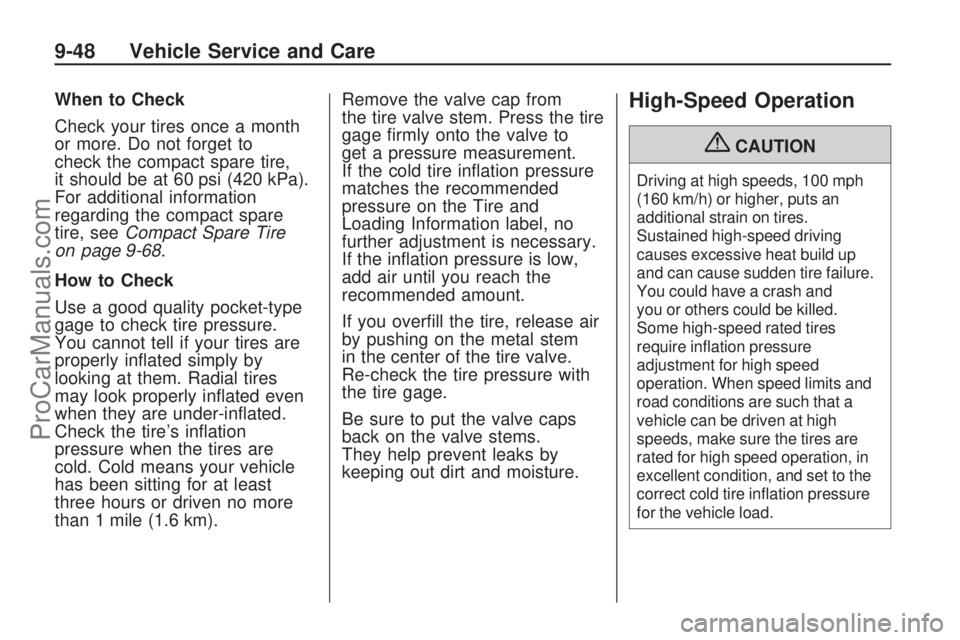
When to Check
Check your tires once a month
or more. Do not forget to
check the compact spare tire,
it should be at 60 psi (420 kPa).
For additional information
regarding the compact spare
tire, seeCompact Spare Tire
on page 9-68.
How to Check
Use a good quality pocket-type
gage to check tire pressure.
You cannot tell if your tires are
properly in�ated simply by
looking at them. Radial tires
may look properly in�ated even
when they are under-in�ated.
Check the tire’s in�ation
pressure when the tires are
cold. Cold means your vehicle
has been sitting for at least
three hours or driven no more
than 1 mile (1.6 km).Remove the valve cap from
the tire valve stem. Press the tire
gage �rmly onto the valve to
get a pressure measurement.
If the cold tire in�ation pressure
matches the recommended
pressure on the Tire and
Loading Information label, no
further adjustment is necessary.
If the in�ation pressure is low,
add air until you reach the
recommended amount.
If you over�ll the tire, release air
by pushing on the metal stem
in the center of the tire valve.
Re-check the tire pressure with
the tire gage.
Be sure to put the valve caps
back on the valve stems.
They help prevent leaks by
keeping out dirt and moisture.High-Speed Operation
{CAUTION
Driving at high speeds, 100 mph
(160 km/h) or higher, puts an
additional strain on tires.
Sustained high-speed driving
causes excessive heat build up
and can cause sudden tire failure.
You could have a crash and
you or others could be killed.
Some high-speed rated tires
require in�ation pressure
adjustment for high speed
operation. When speed limits and
road conditions are such that a
vehicle can be driven at high
speeds, make sure the tires are
rated for high speed operation, in
excellent condition, and set to the
correct cold tire in�ation pressure
for the vehicle load.
9-48 Vehicle Service and Care
ProCarManuals.com
Page 239 of 314
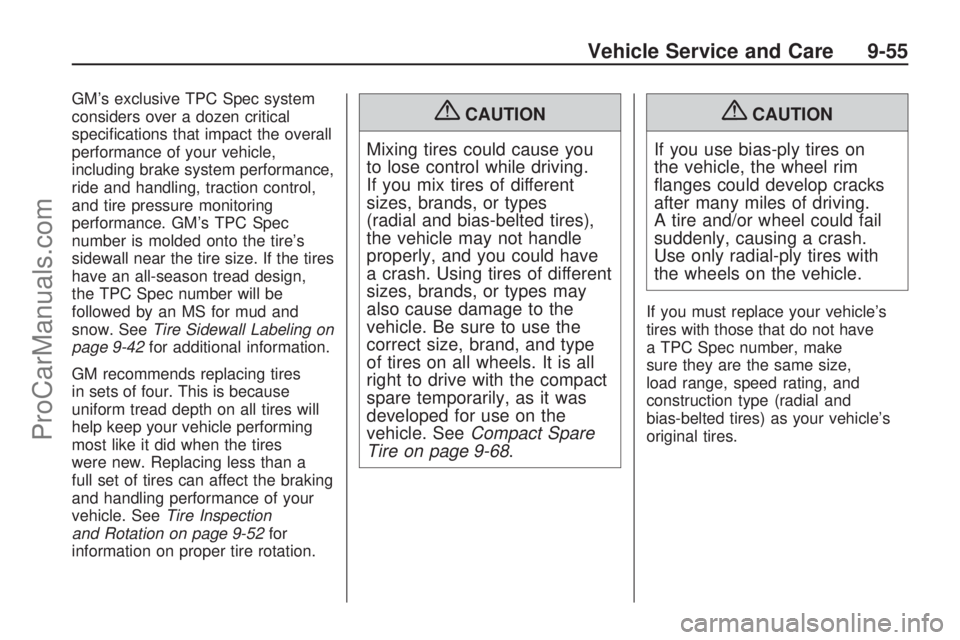
GM’s exclusive TPC Spec system
considers over a dozen critical
speci�cations that impact the overall
performance of your vehicle,
including brake system performance,
ride and handling, traction control,
and tire pressure monitoring
performance. GM’s TPC Spec
number is molded onto the tire’s
sidewall near the tire size. If the tires
have an all-season tread design,
the TPC Spec number will be
followed by an MS for mud and
snow. SeeTire Sidewall Labeling on
page 9-42for additional information.
GM recommends replacing tires
in sets of four. This is because
uniform tread depth on all tires will
help keep your vehicle performing
most like it did when the tires
were new. Replacing less than a
full set of tires can affect the braking
and handling performance of your
vehicle. SeeTire Inspection
and Rotation on page 9-52for
information on proper tire rotation.{CAUTION
Mixing tires could cause you
to lose control while driving.
If you mix tires of different
sizes, brands, or types
(radial and bias-belted tires),
the vehicle may not handle
properly, and you could have
a crash. Using tires of different
sizes, brands, or types may
also cause damage to the
vehicle. Be sure to use the
correct size, brand, and type
of tires on all wheels. It is all
right to drive with the compact
spare temporarily, as it was
developed for use on the
vehicle. SeeCompact Spare
Tire on page 9-68.{CAUTION
If you use bias-ply tires on
the vehicle, the wheel rim
�anges could develop cracks
after many miles of driving.
A tire and/or wheel could fail
suddenly, causing a crash.
Use only radial-ply tires with
the wheels on the vehicle.
If you must replace your vehicle’s
tires with those that do not have
a TPC Spec number, make
sure they are the same size,
load range, speed rating, and
construction type (radial and
bias-belted tires) as your vehicle’s
original tires.
Vehicle Service and Care 9-55
ProCarManuals.com
Page 241 of 314

Uniform Tire Quality
Grading
Quality grades can be found
where applicable on the
tire sidewall between tread
shoulder and maximum section
width. For example:
Treadwear 200 Traction AA
Temperature A
The following information relates
to the system developed by
the United States National
Highway Traffic Safety
Administration (NHTSA),
which grades tires by treadwear,
traction, and temperature
performance. This applies
only to vehicles sold in the
United States. The grades are
molded on the sidewalls of
most passenger car tires.
The Uniform Tire Quality
Grading (UTQG) system
does not apply to deep tread,winter-type snow tires,
space-saver, or temporary use
spare tires, tires with nominal rim
diameters of 10 to 12 inches
(25 to 30 cm), or to some
limited-production tires.
While the tires available on
General Motors passenger cars
and light trucks may vary
with respect to these grades,
they must also conform to
federal safety requirements and
additional General Motors
Tire Performance Criteria (TPC)
standards.
Treadwear
The treadwear grade is a
comparative rating based on
the wear rate of the tire
when tested under controlled
conditions on a speci�ed
government test course.For example, a tire graded 150
would wear one and a half (1.5)
times as well on the government
course as a tire graded 100.
The relative performance of tires
depends upon the actual
conditions of their use, however,
and may depart signi�cantly from
the norm due to variations in
driving habits, service practices,
and differences in road
characteristics and climate.
Traction – AA, A, B, C
The traction grades, from highest
to lowest, are AA, A, B, and C.
Those grades represent the
tire’s ability to stop on wet
pavement as measured under
controlled conditions on
speci�ed government test
surfaces of asphalt and
concrete. A tire marked C may
have poor traction performance.
Vehicle Service and Care 9-57
ProCarManuals.com
Page 244 of 314
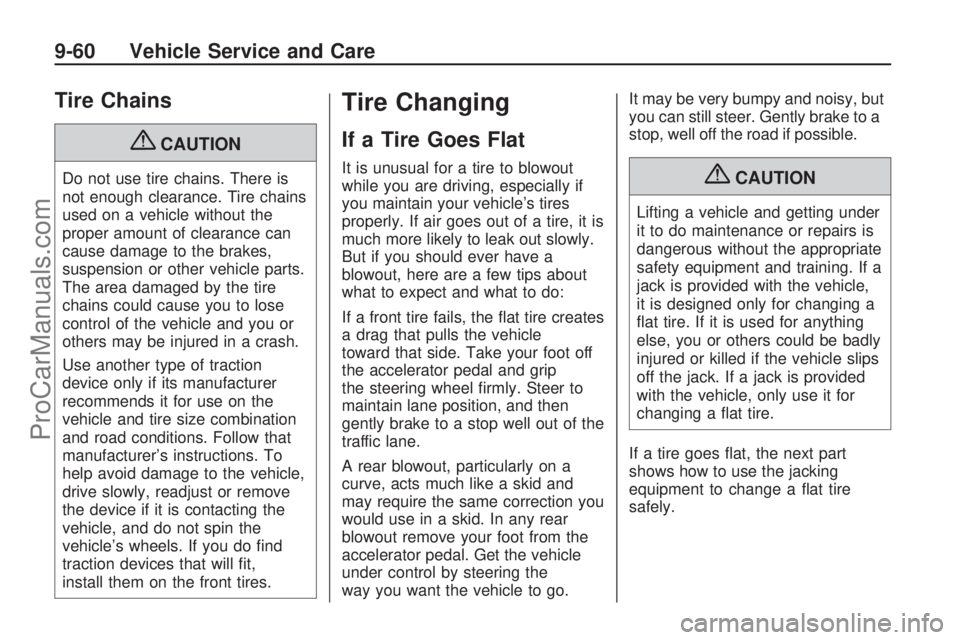
Tire Chains
{CAUTION
Do not use tire chains. There is
not enough clearance. Tire chains
used on a vehicle without the
proper amount of clearance can
cause damage to the brakes,
suspension or other vehicle parts.
The area damaged by the tire
chains could cause you to lose
control of the vehicle and you or
others may be injured in a crash.
Use another type of traction
device only if its manufacturer
recommends it for use on the
vehicle and tire size combination
and road conditions. Follow that
manufacturer’s instructions. To
help avoid damage to the vehicle,
drive slowly, readjust or remove
the device if it is contacting the
vehicle, and do not spin the
vehicle’s wheels. If you do �nd
traction devices that will �t,
install them on the front tires.
Tire Changing
If a Tire Goes Flat
It is unusual for a tire to blowout
while you are driving, especially if
you maintain your vehicle’s tires
properly. If air goes out of a tire, it is
much more likely to leak out slowly.
But if you should ever have a
blowout, here are a few tips about
what to expect and what to do:
If a front tire fails, the �at tire creates
a drag that pulls the vehicle
toward that side. Take your foot off
the accelerator pedal and grip
the steering wheel �rmly. Steer to
maintain lane position, and then
gently brake to a stop well out of the
traffic lane.
A rear blowout, particularly on a
curve, acts much like a skid and
may require the same correction you
would use in a skid. In any rear
blowout remove your foot from the
accelerator pedal. Get the vehicle
under control by steering the
way you want the vehicle to go.It may be very bumpy and noisy, but
you can still steer. Gently brake to a
stop, well off the road if possible.{CAUTION
Lifting a vehicle and getting under
it to do maintenance or repairs is
dangerous without the appropriate
safety equipment and training. If a
jack is provided with the vehicle,
it is designed only for changing a
�at tire. If it is used for anything
else, you or others could be badly
injured or killed if the vehicle slips
off the jack. If a jack is provided
with the vehicle, only use it for
changing a �at tire.
If a tire goes �at, the next part
shows how to use the jacking
equipment to change a �at tire
safely.
9-60 Vehicle Service and Care
ProCarManuals.com